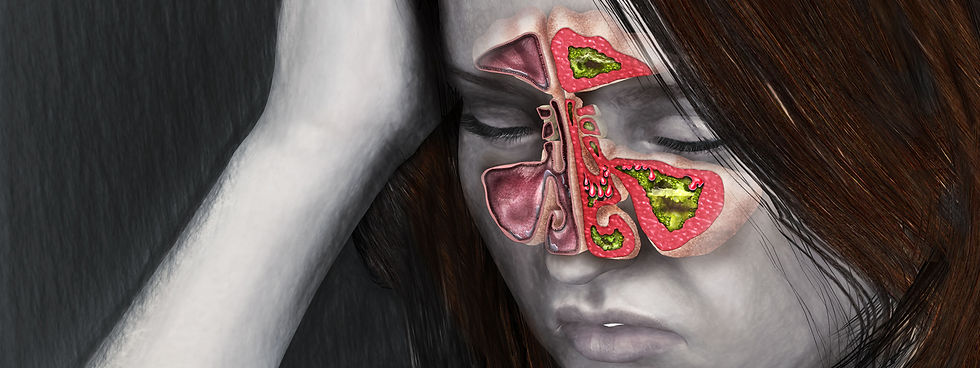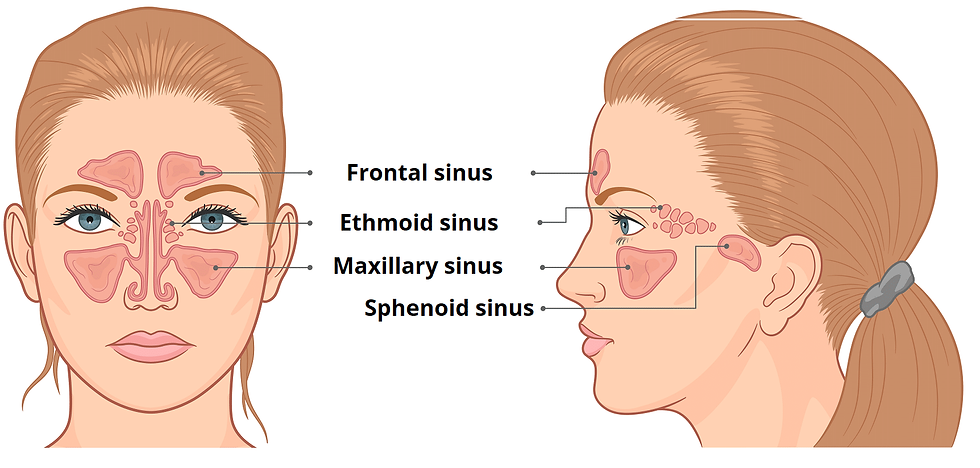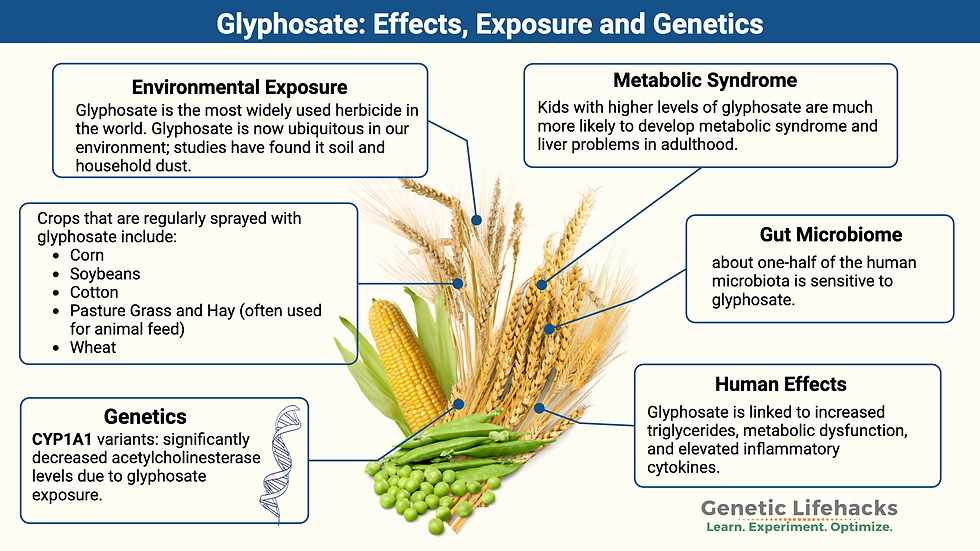SINUSES: WHY WE NEED THEM
- Joan Rothchild Hardin

- Jul 27, 2024
- 9 min read
Updated: Jul 28, 2024

My Allergies, Sinusitis & Nasal Polyps Story of Woe
I want to start this off with the story of my own upper respiratory allergies and the chronic sinus misery they caused me for decades.
I got to the point where I couldn't breathe through my nose. This made it hard to sleep and eat. I lost my sense of smell and taste. I felt exhausted all the time. The allergies made my eyes highly sensitive to light so I had to wear sunglasses all the time, even indoors. I tried a variety of decongestants (which dried up my head so much I felt like it was full of concrete) and antihistamines (which made my heart race). But none of the doctor-prescribed pharmaceuticals helped.
My most frightening reaction was to a combination decongestant/antihistamine capsule the doctor said would for sure clear up the problem. Apparently, most people tolerate the two types of drugs in combination. In me, the two drugs in combination rendered me unable to stand up while my heart raced so severely I thought it would explode and my husband would find me dead on the living room couch.

My sinuses got so bad I needed to have groups of nasal polyps surgically removed. They grew back so I needed the same surgery the following year. It resembles having your brains pulled out through your nose without anesthetic. After the second surgery, I told my ENT I couldn't live like that and was going to figure out how to help myself. He was a good guy and asked me to let him know what I discovered.
I started looking into non-pharmaceutical ways to fix my sinuses so I could breathe again and stop producing nasal polyps that were clearly a sign of massive inflammation. This decision led me away from Western medicine with its dependence on pharmaceuticals and down the path of natural remedies to restore and keep my health. My sinuses greatly improved and I never grew nasal polyps again.
I'm still on that path and have been happy to share what I've learned with other people who have gone on to fix their own allergies, sinuses, asthma and autoimmune diseases.
Human Sinuses

Sinuses are cavities – hollow air spaces inside the bones of the head surrounding the nose. As shown in the photo below, there are four pair of sinuses in the human head.

They are lined with soft pink tissue called the mucosa. Healthy sinuses are empty except for that thin layer of mucus.
Purposes of Sinuses
I used to think my sinuses were there only to make me miserable.

Their actual purposes:
The nose and sinuses are lined with a layer of mucous-producing cells.
They secrete mucous to protect against infection and humidify the air we breathe on its way to the lungs.
The thin mucous layer traps dirt, dust and pollutants that then drains out into the throat. We swallow it all and it's ultimately destroyed by our stomach acid.
Sinuses lighten the weight of the skull. Each sinus opening is inside the partly hollow cranial bone. These large empty spaces in our skulls lighten the weight of our heavy, big-brained heads so we’re unlike the rhinoceros, who only has two small sinuses in its huge skull. A rhino’s head is so heavy, the animal often has to rest it on the ground. Without sinuses, we wouldn’t be able to walk upright on two legs.

The sinuses also act as a crumple zone to safeguard the skull in case of an injury to the face. Think of sinuses as air pillows protecting the face from trauma.
Sinus Infections
Sinus infections are generally caused by a combination of bacteria, viruses and molds living in colonies inside biofilms. See: FASCINATING BIOFILMS: The Source of Life on Earth - and Misery When They Take Up Residence in Our Sinuses
Sinus infections happen when fluid builds up in the air-filled pockets in the sinuses. This fluid buildup allows pathogenic germs to proliferate.
Healthy Sinuses vs Infected Sinuses

How Mold Causes Sinus Infections
Some people are more prone to being affected by sinusitis caused by mold. This is because they have a gene in their DNA that makes them more susceptible to the effects of mold.
When mold spores find their way into the sinus cavity, the immunity in the body reacts by releasing chemicals known as eosinophils to fight the invaders This substance is what causes fungal sinusitis and will cause irritation for as long as the fungi are inside the sinus.
Fungi thrive in damp, dark environments so sinus cavities are the perfect host environment and this type of sinus infection can be hard to get rid of. See: Is Mold Causing Your Sinus Infection?
A Fungal Sinus Infection

Common Symptoms of Fungal Sinusitis:
Swellings in the nasal cavity
Runny nose
Poor sense of smell
Headache
Body ache
Tingly rashes
Post-nasal drip
Cough
Invasive fungal sinusitis infections are commonly caused by inhaling certain types of mold spores. One of the more common spores that cause invasive fungal sinusitis is aspergillosis fumigatus, which is found indoors and outdoors on dead leaves, stored grains and decaying vegetation.
Most people breathe in fungal spores every day without getting sick - but those with a weakened immune system are more at risk of developing an invasive fungal sinusitis infection.
Chronic Sinusitis
Chronic sinusitis was what I suffered with for decades. This image pretty much describes how my sinuses hindered my life:

Allergies are Autoimmune Conditions
When the immune system stops recognizing as “self” something that’s a normal constituent of the body, it starts producing antibodies that attack the body’s own cells, tissues, and/or organs. This produces chronic low-level inflammation that damages these body parts and leads to autoimmune problems.
This is my shorthand description of how autoimmune conditions and diseases get created over time:
INFLAMMATORY DIET --> LEAKY GUT --> CHRONIC LOW-LEVEL INFLAMMATION IN THE BODY --> INTERACTION WITH GENETIC PREDISPOSITIONS --> AUTOIMMUNE DISEASES & CONDITIONS
Healthy inflammation
Inflammation is part of the body’s defense mechanism. It’s the process by which the immune system recognizes and removes harmful and foreign stimuli and begins the healing process. Inflammation can be either acute – as when you have a cut – or chronic.
Low-level chronic inflammation
This is the problematic type of inflammation - the kind that produces allergies and the other types of autoimmune diseases and conditions. Low-level chronic inflammation develops from a Leaky Gut that allows incompletely digested food particles and bacteria to escape through the gut walls out into the body, where they’re treated like dangerous foreign invaders.

Climate Change Creates Increased Allergens: Pollens & Fungi
Extreme weather events, from coastal flooding, intense heat, record amounts of rainfall in some areas and historic droughts in others, are becoming increasingly common as the Earth’s average temperature rises.
This is very bad news for the entire planet, including people with allergies and asthma – more moisture and higher temperatures mean increased levels of mold, pollen and air pollution.

Antibiotics Harm Our Microbiones: Gut, Oral & Nasal
Antibiotics have a huge, deleterious impact on the friendly bacteria living in our gut microbiomes … and from there to the rest of the body.
Wreck your gut microbiome. Wreck your health.

In order to keep animals alive living in overcrowded, unhealthy conditions on factory farms, they receive 80% of the antibiotics consumed in the US.

Antibiotics are also overused by humans.

Glyphosate and Allergies
Environmental Toxins (GMO foods contaminated with pesticides, herbicides, viruses) kill probiotic gut microbes, damaging the balance of healthy to pathogenic critters making up your gut flora.
When you consume fruits, veggies grown from genetically modified seeds and then sprayed with RoundUp (the toxic pesticide glyphosate) - or eat processed foods made from these GMO foods, eat animals fed GMO feed - or eat products from these animals (milk, other dairy products, eggs), you're eating poison. A steady diet of these toxic foods will undermine your health.

"The genetic engineering of food creates two separate and serious health risks involving allergenicity. The first is that genetic engineering can transfer allergens from foods to which people know they are allergic, to foods that they think are safe (emphasis added). This risk is not hypothetical. A study by the New England Journal of Medicine showed that when a gene from a Brazil nut was engineered into soybeans, people allergic to nuts had serious reactions to the engineered product. At least one food, a Pioneer Hi-Bred International soybean, was abandoned because of this problem. Without labeling, people with known food allergies have no way of avoiding the potentially serious health consequences of eating GE foods containing hidden allergenic material.
"There is another allergy risk associated with GE foods. These foods could be creating thousands of different and new allergic responses. Each genetic “cassette” being engineered into foods contains a number of novel proteins (in the form of altered genes, bacteria, viruses, promoters, marker systems, and vectors) which have never been part of the human diet. Each of these numerous novel proteins could create an allergic response in some consumers. The FDA was also well aware of this new and potentially massive allergenicity problem. The agency’s scientists repeatedly warned that genetic engineering could “produce a new protein allergen.”
Once again the agency’s own scientists urged long-term testing. However, the FDA again ignored its own scientists. Center for Food Safety: GE Food & Your Health
Glyphosate (RoundUp) Poisons Humans, Animals & the Planet Every Day

“Exposure to environmental pollutants via food, particularly during the prenatal and early postnatal periods, has been linked to adverse effects on the immune system. Among these pollutants, the widely used pesticide glyphosate has been associated with endocrine disruption, autism, and cancer. Occupational high exposure to glyphosate has also been shown to influence immune function and exacerbate allergic asthma.” NIH National Library of Health
History of Glyphosate, Monsanto & Bayer
The glyphosate-based herbicide Roundup was first developed by Monsanto in the 1970s. It is used most heavily on corn, soy, and cotton crops that have been genetically modified to be resistant to the herbicide.
Monsanto was purchased by Bayer in 2018.
A bit of info about war and other crimes committed by both companies:
Monsanto:
From 1965 to 1969, the company manufactured Agent Orange for the US military as a wartime government contractor. If you're old enough to remember the US's Vietnam War, you'll have seen grizzly pictures of Vietnamese children after US planes sprayed Agent Orange sprayed on them.
In 2017, the International Monsanto Tribunal found the company declared that Monsanto’s activities adversely affect more than the world’s access to food. They declare that they also negatively affect the human right to health. They also find the company guilty of perverting scientific freedom. The Tribunal describes itself as “an international civil society initiative to hold Monsanto accountable for human rights violations, for crimes against humanity, and for ecocide."
Bayer:
You may associate this giant German multinational pharmaceutical and biotechnology company with the bottle of Bayer Aspirin in your bathroom medicine cabinet. During WW II, Bayer strongly supported Hitler's Third Reich.
It used slave labor in factories it built inside Nazi concentration camps.
Between 1942 to 1945, to support Hitler's Final Solution (the Nazis' plan to annihilate Jews), Bayer manufactured Zyklon B, a cyanide-based pesticide, to kill over a million people, mostly Jews, in Nazi-run gas chambers.
Bayer also paid Nazi doctors to test experimental drugs and perform gruesome operations on unwilling human subjects in the concentration camps.
If you have the stomach for it, you can read more about Monsanto's & Bayer's numerous crimes:
Clean Up Your Diet to Help Your Sinuses - and the rest of you
If you suffer from allergies, chronic sinusitis or sinus infections, you could benefit from cleaning up your diet. Making the effort to avoid consuming the toxins in GMO foods will go a long way to improve your gut microbiome, where 80% of your immune system lives.
Genetically modified organisms (GMOs) are organisms that contain artificially altered genetic material that would not otherwise occur in nature. Scientists physically edit the DNA of an organism to achieve a desired change - like making plants resistant to glyphosate so they can be heavily sprayed with RoundUp to kill the weeds around them.
Genetic modification is different from selective breeding, the age-old process of breeding plants or animals with the most desired traits. Selective breeding is how people grew wheat with bigger kernels, bred chickens to have large breasts and legs and turned wolves into corgis. While this breeding did change the genes of those species, today “genetic engineering” refers instead to the direct editing of DNA to cause changes in an organism.

VITAMINS THAT REDUCE HISTAMINES
Vitamin D is crucial to many physiological processes in the body, including immune regulation. Studies have linked vitamin D deficiency to an increased incidence of allergy symptoms. Research suggests an association between vitamin D deficiency and increased histamine levels in the body. And most of us are woefully D deficient!

Vitamin C is a natural antihistamine and antioxidant, helpful for reducing inflammation, swelling and other symptoms that happen at the site of an allergic reaction.

© Copyright 2024 Joan Rothchild Hardin. All Rights Reserved.
DISCLAIMER: Nothing on this site is intended to provide medical advice, diagnosis or treatment.


Comments